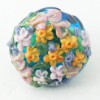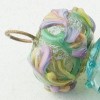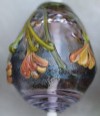I've been wanting to come up with a pretty violet-tinged blue cane for awhile, and this morning I attempted one using pastel (opaque) 224 light sky blue as a base. For my first effort, I doubled over a rod, rolled it to a slightly thicker cylinder, cased with a thin layer of ink blue, made six indents and filled every other one with rod-thickness periwinkle. The result is a very subtle, but fairly attractive light blue cane, suitable for something like, say, forget-me-nots.
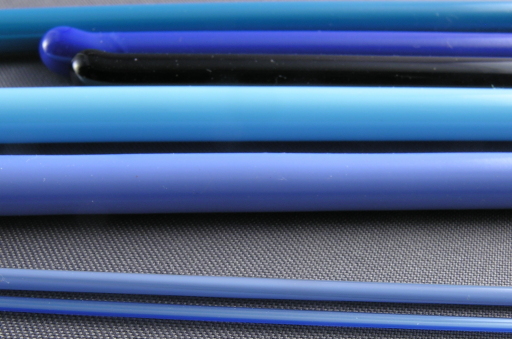
Two experimental blue canes, and the rods used to make them: from front to back: periwinkle, light sky blue, ink blue (transparent), light cobalt blue, darkest (vetrofond) turquoise. Not shown: medium transparent aqua. The first three colors were used in the round cane, in back; all but the periwinkle were used in the ribbon cane, front.
For my second effort, I paddled the 224 light sky blue into a rectangular oblong, and rather carelessly cased one side with a medium aqua and the other with the ink blue, then striping both with double layers of stringer (rather than rod) of the darkest opaque turquoise (the vetrofond one) I had. That looked pretty bland, so I cased the exposed sides of the rectangle with the lightest opaque cobalt I had, and also added a stripe of the cobalt to the aqua side of the tab. The first photo, above, shows the ink blue side of the ribbon; the one below, the aqua side.

Obverse. Note the darker blue stripes of light opaque cobalt on the ribbon cane. These canes are roughly 1.5mm in thickness, which I find to be just about ideal. I was going to twist the ribbon cane to get the two sides, but as you'll see in the bead, mostly failed in that goal, showing primarily this side of the cane.
Now for the beads. I made two beads, one each with these canes, to see how they looked:
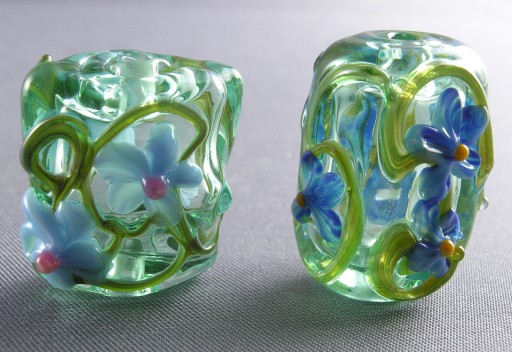
Two florals, 18x21x12mm and 15x17x23mm. Check glass hollow pressed bases, the rectangle with mashers only. See text for exact recipes of effetre floral canes.
As you can see, the photo is a touch backlit, but I was too lazy to reshoot it, and it's still pretty easy to see how the canes look on a bead. The round periwinkle and ink blue cane is shown on the left bead; the turquoise and cobalt striped ribbon cane is on the right bead. These canes read as monochromes, that is, blue on blue. It's perfectly acceptable; however, casing with analogous (side-by-side on the color wheel) colors can give more liveliness to one's canes (e.g. purple on blue) as opposed to the more traditional blue-on-blue: I shifted a little, with the purplish ink blue, but it wasn't really enough.
—The standard dark transparent purple on periwinkle (a violet based light blue) is a classic combination; I wonder whether a medium purple would liven up the more greenish sky blue? Or I could just put down a standard thick casing of the ink blue, instead of the thin one I used...Well, I'll just have to do more experiments, I guess:)
beads, photos, post, all 18oct08.
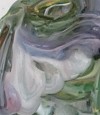
Yet another round of attempting to do the perfect transparent/opaque striped cane—opaque in the center, trans at the edges. With stripes. 29apr2013

purple glass button. Also, brief discussion of the colors I like to use for making leaf cane. 12mar2006
Unless otherwise noted, text, image and objects depicted therein copyright 1996--present sylvus tarn.
Sylvus Tarn
